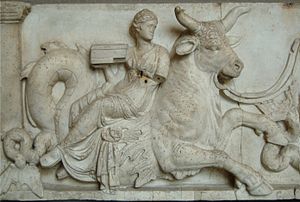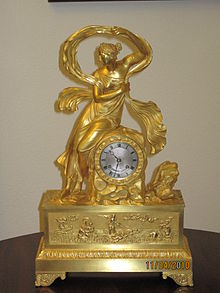- Nereid
-
In Greek mythology, the Nereids (
 /ˈnɪəriɪdz/ neer-ee-idz; Ancient Greek: Νηρηΐδες) are sea nymphs, the fifty daughters of Nereus and Doris, sisters to Nerites. They often accompany Poseidon and can be friendly and helpful to sailors fighting perilous storms. They are particularly associated with the Aegean Sea, where they dwelt with their father in the depths within a silvery cave. The most notable of them are Thetis, wife of Peleus and mother of Achilles; Amphitrite, wife of Poseidon; and Galatea, love of the Cyclops Polyphemus.
/ˈnɪəriɪdz/ neer-ee-idz; Ancient Greek: Νηρηΐδες) are sea nymphs, the fifty daughters of Nereus and Doris, sisters to Nerites. They often accompany Poseidon and can be friendly and helpful to sailors fighting perilous storms. They are particularly associated with the Aegean Sea, where they dwelt with their father in the depths within a silvery cave. The most notable of them are Thetis, wife of Peleus and mother of Achilles; Amphitrite, wife of Poseidon; and Galatea, love of the Cyclops Polyphemus.In Iliad XVIII, when Thetis cries out in sympathy for the grief of Achilles for the slain Patroclus,
“ There gathered round her every goddess, every Nereid that was in the deep salt sea. Glauce was there and Thaleia and Cymodoce; Nesaea, Speio, Thoe and ox-eyed Halie; Cymothoe, Actaee and Limnoreia; Melite, Iaera, Amphithoe and Agaue; Doto, Proto, Pherusa and Dynamene; Dexamene, Amphinome and Callianeira; Doris, Panope and far-sung Galatea; Nemertes, Apseudes and Callianassa. Clymene came too, with Ianeira, Ianassa, Maera, Oreithuia, Amatheia of the lovely locks, and other Nereids of the salt sea depths. The silvery cave was full of nymphs. ” -
- (E.V. Rieu, translator)
The Nereids are the namesake of one of the moons of the planet Neptune.
The nymph Opis is mentioned in Virgil's Aeneid. She is called on by the goddess Diana to avenge the death of the Amazon-like female warrior Camilla. Diana gives Opis magical weapons with which to take revenge on Camilla's killer, the Etruscan Arruns. Opis sees and laments Camilla's death and shoots Arruns in revenge as directed by Diana. This information is from 'Virgil, his life and times' by Peter Levi, Duckworth, 1998.
Names of the Nereids
Greek deities
seriesPrimordial deities Titans and Olympians Chthonic deities Personified concepts Other deities Aquatic deities Nymphs This list is correlated from four sources: Apollodorus, Hesiod, Homer, and Hyginus. Because of this the total number of names goes beyond fifty.[1]
- Actaea
- Agave
- Amathia
- Amphinome
- Amphithoe
- Amphitrite
- Apseudes
- Arethusa
- Asia
- Autonoe
- Beroe
- Callianassa
- Callianira
- Calypso
- Ceto
- Clio
- Clymene
- Cranto
- Creneis
- Cydippe
- Cymo
- Cymatolege
- Cymodoce
- Cymothoe
- Deiopea
- Dero
- Dexamene
- Dione
- Doris
- Doto
- Drymo
- Dynamene
- Eione
- Ephyra
- Erato
- Eucrante
- Eudore
- Eulimene
- Eumolpe
- Eunice
- Eupompe
- Eurydice
- Evagore
- Evarne
- Galene
- Galatea
- Glauce
- Glauconome
- Halie
- Halimede
- Hipponoe
- Hippothoe
- Iaera
- Ianassa
- Ianeira
- Ione
- Iphianassa
- Laomedeia
- Leiagore
- Leucothoe
- Ligea
- Limnoria
- Lycorias
- Lysianassa
- Maera
- Melite
- Menippe
- Nausithoe
- Neaera
- Nemertes
- Neomeris
- Nesaea
- Neso
- Opis
- Orithyia
- Panopea (Panope)
- Pasithea
- Pherusa
- Phyllodoce
- Plexaure
- Ploto
- Polynome
- Pontomedusa
- Pontoporeia
- Poulunoe
- Pronoe
- Proto
- Protomedeia
- Psamathe
- Sao
- Speio
- Thaleia
- Themisto
- Thetis
- Thoe
- Xantho
In modern Greek folklore, the term "nereid" (νεράϊδα, neráïda) has come to be used of all nymphs, or fairies, not merely nymphs of the sea.
References
External links
- Nereids in classical literature and art
- Nereid and Triton Mosaic from Ephesus Terrace Home -2
- 3D stereoview of Nereid and Triton relief from Apollon Temple in Didim
Greek mythology (deities) Primordial
deitiesMoirai (Fates)Titan
deitiesTitanesTitanidesHyperionidesKoionidesKrionidesIapetionidesOlympian
deitiesDodekatheonTheoi OlympioiMousai (Muses)Charites (Graces)- Aglaea
- Euphrosyne
- Thalia
Horae (Hours)StyktidesOceanic
deitiesTheoi HalioiNereidesChthonic
deitiesTheoi KhthonioiErinyes (Furies)Earthborn- Hecatonchires
- Cyclopes
- Gigantes
- Kouretes
- Meliae
- Telkhines
- Typhon
Apotheothenai- Iacchus
- Trophonius
- Triptolemus
- Orpheus
- Minos
- Aeacus
- Rhadamanthys
Categories:- Nymphs
- Greek mythology
- Greek legendary creatures
- Nereids
- Water spirits
- Greek sea gods
-
Wikimedia Foundation. 2010.


